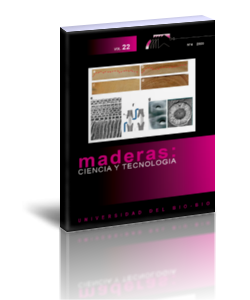Cutting energy required during the mechanical processing of wood species at different drying stages
Keywords:
Basic density, CNC, energy analyzer, moisture content, wood processingAbstract
The aim of this study was to know the variation profile of the specific energy consumption required to cut woods with varying densities and moisture contents. Therefore, peripheral cuts were performed in the longitudinal direction of the grain with numerical control controlled by Computational Numerical Command in woods of different densities, established at different drying stages. An energy analyzer, capable of calculate the specific energy consumed during the wood processing, was used to measure the energy information. The results indicated that the higher the wood density, the greater the positive influence of the moisture content on the specific cutting energy. In the anhydrous condition, the higher the wood density, the higher the cutting energy. With increased moisture content, less cutting power was required during the wood processing. Therefore, it was possible to conclude that during the milling type mechanical processing of wood, moisture content has a great influence on the specific cutting energy consumption.
Downloads
References
Axelsson, B.; Lundberg, S.; Grönlund, A. 1993. Studies of the main cutting force at and near a cutting edge. Holz Roh Werkst 51(1): 43-48. https://doi.org/10.1007/BF02615376
Barcík, Š.; Pivuloskova, E.; Kminiak, R. 2008. Effect of technological parameters and wood properties on cutting power in plane milling of juvenilie poplar wood. Drvna ind 59(3): 107-112. https://hrcak.srce.hr/29380
Chardin, A. 1954. Peut-on scier tous les bois avec la même denture. Bois for trop 33(33): 41-50. https://revues.cirad.fr/index.php/BFT/article/view/18559/18318
Eyma, F.; Méaуsoone, P.; Martin, P. 2004. Study of the properties of thirteen tropical wood species to improve the prediction of cutting forces in mode B. Ann Forest Sci 61(1): 55-64. https://www.afs-journal.org/articles/forest/pdf/2004/01/F4106.pdf
Forest Products Laboratory. 1973. Standard terms for describing wood (USDA). Forest Products Laboratory Research Paper. Madison. https://www.fpl.fs.fed.us/documnts/fplrn/fplrn171.pdf
Franz, N.C. 1958. An analysis of the wood cutting process. PhD thesis, University of Michigan Press, Ann Arbor, Michigan, USA. https://doi.org/10.3998/mpub.9690780
Glass, S.V.; Zelinka, S.L. 2010. Moisture relations and physical properties of wood. Wood handbook: wood as an engineering material: chapter 4. Centennial ed. General technical report FPL; GTR-190. Madison, WI: US Dept. of Agriculture, Forest Service, Forest Products Laboratory 190: 4.1-4.19. https://www.fs.usda.gov/treesearch/pubs/37428
Günay, M.; Korkut, I.; Aslan, E.; Şeker, U. 2005. Experimental investigation of the effect of cutting tool rake angle on main cutting force. J mater process tech 166(1): 44-49. https://doi.org/10.1016/j.jmatprotec.2004.07.092
Hernández, R.E. 2007. Influence of accessory substances, wood density and interlocked grain on the compressive properties of hardwoods. Wood sci technol 41: 249. https://doi.org/10.1007/s00226-006-0114-5
Koch, P. 1964. Wood Machining Processes. Finland Institute for Technical Research. New York: Ronald Press.
Loehnertz, S.P.; Cooz, I.V. 1998. Sawtooth forces in cutting tropical hardwoods native to South America. Madison, WI: US Department of Agriculture, Forest
Service, Forest Products Laboratory, 16-p. https://www.fpl.fs.fed.us/documnts/fplrp/fplrp567.pdf
Ma, J.; Ge, X.; Chang, S.I.; Lei, S. 2014. Assessment of cutting energy consumption and energy efficiency in machining of 4140 steel. Int j adv manuf technol 74(9-12): 1701-1708. https://doi.org/10.1007/s00170-014-6101-3
Mandić, M.; Porankiewicz, B.; Danon, G. 2015. An Attempt at Modelling of Cutting Forces in Oak Peripheral Milling. BioResources 10(3): 5489-5502. https://ojs.cnr.ncsu.edu/index.php/BioRes/article/view/BioRes_10_3_5489_Mandic_Modelling_Cutting_Forces_Oak
Mckenzie, W.M. 1961. Fundamental analysis of the wood-cutting process. Department of Wood Technology, School of Natural Resources, Univ. of Michigan, Ann Arbor, USA. http://hdl.handle.net/2027.42/6536
Melo, L.E.L.; Da Silva, J.R.M.; Napoli, A.; Lima, J.T.; Trugilho, P.F.; Nascimento, D.F.R. 2016. Influence of genetic material and radial position on the anatomical structure and basic density of wood from Eucalyptus spp. and Corymbia citriodora. Sci For 44(111): 611-621. dx.doi.org/10.18671/scifor.v44n111.07
Nascimento, R.F.D.; Melo, L.E.E.; Silva, M.R.J, Trugilho; F.P. Napoli, A. 2017. Effect of moisture content on specific cutting energy consumption in Corymbia citriodora and Eucalyptus urophylla woods. Sci For 45(113): 221-227. http://dx.doi.org/10.18671/scifor.v45n113.22
Naylor, A.; Hackney, P.; Perera, N.; Clahr, E. 2012. A predictive model for the cutting force in wood machining developed using mechanical properties. BioResources 7(3): 2883-2894. https://ojs.cnr.ncsu.edu/index.php/BioRes/article/view/2756
Pantaleo, A.; Pellerano, A. 2013. Assessment of wood particleboards milling by means of energy consumption tests. Wood Mater Sci Eng 9(4): 193-201. https://doi.org/10.1080/17480272.2013.847494
Souza, E.M.D.; Silva, J.R.M.D.; Lima, J.T., Napoli, A., Raad, T.J.; Gontijo, T.G. 2011. Specific cutting energy consumption in a circular saw for Eucalyptus stands VM01 and MN463. Cerne 17(1): 109-115. https://doi.org/10.1590/S0104-77602011000100013
Zhu, Z.; Buck, D.; Ekevad, M.; Marklund, B.; Guo, X.; Cao, P.; Zhu, N. 2019. Cutting forces and chip formation revisited based on orthogonal cutting of Scots pine. Holzforschung 73(2): 131-138. https://doi.org/10.1515/hf-2018-0037

































